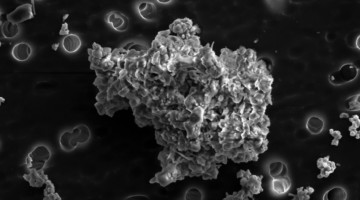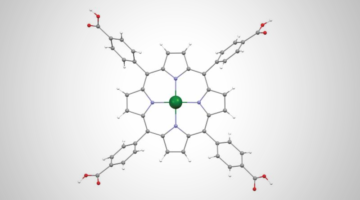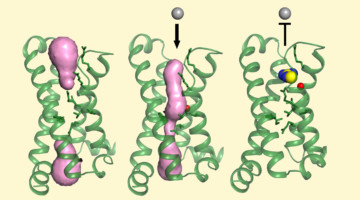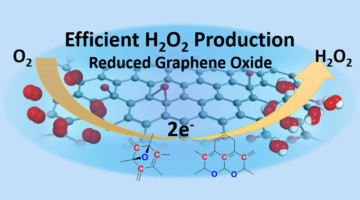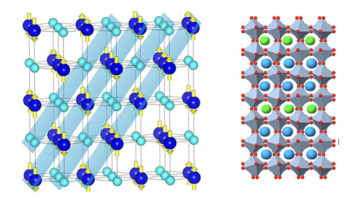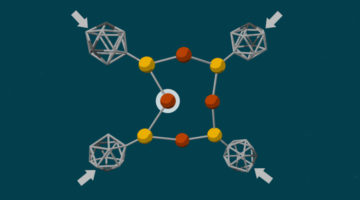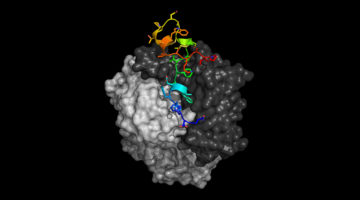In comet dust, researchers discovered composite organic-inorganic mineral grains that are likely to be the original “bricks and mortar” of the solar system. “Forensic” samples preserved from the birth of the solar system allow investigations into the nature of the atomic and molecular ancestry of the terrestrial planets and life on Earth. Read more »![]()
![]()
Science Highlights
A 2D Lattice of Molecular Qubits for Quantum Computing
Researchers developed a way to build a 2D lattice of molecular-spin qubits (quantum bits of information), with control over qubit orientation and localization. The work enables the integration of molecular quantum-information hardware into the scalable, robust, solid-state architectures needed for performing quantum computation. Read more »![]()
![]()
Structure Reveals Mechanism Behind Periodic Paralysis
X-ray crystallography of a membrane protein provided a structural understanding of how a single mutation can result in periodic muscle paralysis. The results suggest possible drug designs that could provide relief to patients with a genetic disorder that causes them to be overcome suddenly with profound muscle weakness. Read more »![]()
![]()
Graphene-Based Catalyst Improves Peroxide Production
Scientists characterized a graphene-based electrocatalyst that potentially makes the production of hydrogen peroxide more selective, efficient, and cost effective. Hydrogen peroxide is an important commodity chemical with growing demand in many areas, including the electronics industry, wastewater treatment, and paper recycling. Read more »![]()
![]()
A Designed Material Untangles Long-Standing Puzzle
The origin of the metal-to-insulator transition in a key material system was revealed by nanostructures designed to decouple simultaneous phase transitions. This approach could lead to new materials with emergent physics and unique electronic properties, supporting broader research efforts to revolutionize modern electronics. Read more »![]()
![]()
Structures Reveal New Target for Malaria Vaccine
Researchers isolated human-derived antibodies that protect against malaria, and protein-structure studies revealed the antibodies’ site of attack. The discovery paves the way for the development of a more effective and practical human vaccine for malaria, which is responsible for half a million deaths every year. Read more »![]()
![]()
Molecular Anvils Trigger Chemical Reactions
“Molecular anvils” (diamondoids) were used to trigger chemical reactions using pressure, yielding products that differ from those produced in conventionally driven reactions with the same reactants. The discovery opens up new possibilities for the high-specificity synthesis of valuable but challenging molecules in an environmentally friendly process. Read more »![]()
![]()
The Electronic Structure of a “Kagome” Material
Scientists have verified exotic electronic properties predicted to emerge in a ferromagnetic material with “kagome” (trihexagonal) lattice symmetry. The greater understanding of kagome materials afforded by this work helps open up a new path toward goals such as ultralow-power electronic devices and quantum computing. Read more »![]()
![]()
Rational Optimization of Organic Solar-Cell Materials
Researchers have established a new quantitative model that connects molecular interactions in organic solar-cell materials to device performance. The work suggests a way to quickly identify ideal material mixtures and processing methods, bypassing trial-and-error strategies and minimizing labor-intensive synthesis. Read more »![]()
![]()
Respiratory Virus Study Points to Likely Vaccine Target
Respiratory syncytial virus (RSV) causes serious respiratory disease in infants and older adults, but no vaccine is yet available. Researchers have now determined the molecular structures of human antibodies bound to an RSV surface protein, providing a promising route for designing a vaccine effective against a broad range of RSV strains. Read more »![]()
![]()
- « Previous Page
- 1
- …
- 13
- 14
- 15
- 16
- 17
- …
- 26
- Next Page »
